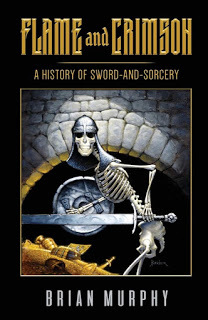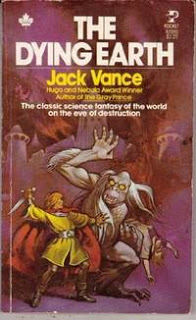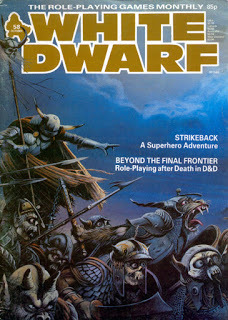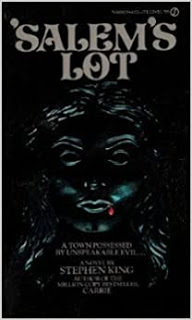Brian Murphy's Blog, page 40
December 8, 2020
Where to start with Karl Edward Wagner's Kane
My latest essay can be found over on the Goodman Games website. "Where to Start with Karl Edward Wagner's Kane" is my first piece for the website of Tales from the Magician's Skull.
I had fun with this one. If you're not interested in clicking through, spoiler alert: I went with the collection Night Winds. I always favor checking out an author's short stories, if available, before committing to a novel, and Night Winds offers a nice representative offering of Kane stories. But it's hard to go wrong with anything Kane.
I've been writing a lot about Kane lately but this is merely a coincidence. Bill Ward asked me to write this latest essay following our recent sword-and-sorcery panel session at Bride of Cyclops Con. I had already been working on the DMR piece prior. And as Deuce Richardson reminded me recently, December 4th marked what would have been Wagner's 75th birthday.
December 3, 2020
Doom scrolling and distraction
I caught myself yesterday mindlessly scrolling my iphone, reading comments on stories about the end of capitalism. Then a story about the inability of developing countries to remove their dependency on fossil fuels, and the accompanying inevitability of the planet’s ecological destruction. Depressing numbers on climbing COVID-19 cases and a looming possibility of 200K more deaths. Political gridlock. Rampant graft and hypocrisy. On and on. Depressing, in a time when the cold weather has arrived and we’re driven inside, and there’s no escape. Winter is coming and it’s not looking good, folks.
Or is it?
This is all part of a larger issue that I think has been conflated and labelled as “fake news.” I would not call all of the aforementioned problems fake, but the feeling of impending doom these types of stories engender is a symptom of being constantly in the news, and people’s Twitter opinions. In short, of this phenomenon called doom scrolling, 24-7. You get to hate it all, you come to hate new media and tech companies for spawning this new world of inattention and distraction and doom scrolling, and so it all becomes fake news. It doesn’t feel real anymore, and it feels like the only ones who are winning are companies like Facebook who are selling my data in increasingly troubling targeted ads (I was talking to my wife about wine yesterday, and sure enough an ad for a wine subscription service came up in my social media feed. And yes, I have Alexa, and it’s probably listening to everything we say at the counter).
So, what do we do about it? What do I do about it?
I’m coming to loathe Facebook, even though it has SOME tangible value. I like seeing what beers are hitting my local liquor stores (I follow a couple liquor store pages), or when a water main breaks in town (I follow Merrimac news), or when someone posts something sword-and-sorcery related (I follow Pulp Sword-and-Sorcery, and a few other groups). I like seeing when people who I’m friends with, post something genuine. That happens too, albeit infrequently.
I could do without all the rest. Either I start mercilessly cutting shit out, and unfollowing, or I limit the amount of usage, maybe to a couple windows of time each day. And get back to living in the real world of my own life, of my job, my private work, my family, my circle of friends. Reality, and not this consumption of digital 1s and 0s that tells me the world is going to hell in a handbasket, and the only way out is to surf the cutting edge by consuming more information and reading the next snarky comment or the next platitude left by some celebrity I vaguely like.
December 1, 2020
Update: Flame and Crimson reviews
 It's hard to believe but I'm closing in on one year since the publication of Flame and Crimson: A History of Sword-and-Sorcery. I sent the final edits over to Bob McLain at Pulp Hero Press in December 2019, and the book was available on Amazon shortly after the turn of the new year. I waited some 5-6 weeks with baited breath for the first reveiws, not knowing if the book sucked, was wildly off-base, boring, etc. To anyone who has ever written a book, we are brothers in arms and I can safely say I don't envy you this experience. I would sort of compare it to baring a piece of my soul with total strangers. Fear of rejection, ridicule, etc. are very real obstacles.
It's hard to believe but I'm closing in on one year since the publication of Flame and Crimson: A History of Sword-and-Sorcery. I sent the final edits over to Bob McLain at Pulp Hero Press in December 2019, and the book was available on Amazon shortly after the turn of the new year. I waited some 5-6 weeks with baited breath for the first reveiws, not knowing if the book sucked, was wildly off-base, boring, etc. To anyone who has ever written a book, we are brothers in arms and I can safely say I don't envy you this experience. I would sort of compare it to baring a piece of my soul with total strangers. Fear of rejection, ridicule, etc. are very real obstacles.To say that I'm happy with the response is an understatement. As of this post it's received 32 reviews on Amazon, averaging 4.7 out of 5 stars. Goodreads has tracked an additional 17 reviews, averaging 4.35 out of 5 stars.
Beyond the numbers, I've been thrilled with the words of those who have taken the time to share their thoughts about the book. I don't know these folks from Adam, but to read comments like these is incalculably rewarding:
I feel like I have been waiting years for someone to write a book like this. Sure, others have tried on occasion, but no one really did a comprehensive capture of the genre before now. And this is not just a history, but a thematic synthesis and-dare I say it-a work of literary criticism.
---
Well structured, researched, and written, this is a great text for those who wish to write in the genre and those who've done some reading, but aren't sure about the best path to take in exploring it further.
---
I admit my vision is rose colored. The author is nearly my age and came upon his love for Swords & Sorcery (he actually prefers swords and sorcery—I am not as picky) in an almost identical way as I. He even shares my adoration of Heavy Metal tunes.
---
Much self-published sf and fantasy criticism is not very good - but Murphy's book is very well written. He is not an academic so we are spared the typical turgid prose that comes from University presses. Highly recommended.
---
All that is most interesting, but Murphy is also ENTERTAINING while explaining. The book is never boring and always fun to read; sometime I actually laughed out loud. But you always feel that he is serious about his topic and the involved research, so it never gets silly. Do yourself a favor and buy this book.
---
If you are at all interested in the history and cultural impact of S&S literature, this book is definitely worth your while. Every time I wanted to raise a little quibble with something the author said, my objection was answered within two pages. Informative and entertaining!
---
Just today I was treated to an amazingly kind review from Bill Ward over at Tales from the Magician's Skull (which if you're a fan of S&S and not subscribed to, you're doing yourself a disservice). This last paragraph made every bit of the six+ years of effort that went into the conception, research, and writing of Flame and Crimson worth the struggle:
I’ve been searching high and low for this book for years, but of course, no one had written it yet! I’m glad Brian Murphy finally did because he has produced no less a seminal work than Lin Carter’s Imaginary Worlds (1973) or Don Herron’s The Dark Barbarian (1984). In recent decades we’ve had some amazing essays and deep scholarship in the field, and a first-rate biography of Robert E. Howard (Mark Finn’s Blood & Thunder), but no one had filled the real need for a single volume, narratively coherent history of sword-and-sorcery until Flame and Crimson. But make no mistake, Murphy’s book isn’t simply good because it’s necessary, it’s indispensable because it’s magnificent.
There are other reviews worth sharing, and I will at some point. Flame and Crimson is certainly not perfect, and there are things I wish I had done differently.
But for now, to anyone who has read and enjoyed this book, THANK YOU. I hope in some measure I have helped to illuminate the highs (and fun lows) of this remarkable fantasy subgenre. And have entertained you along the way.
November 26, 2020
Bloodstone and The Lord of the Rings post up on DMR blog
During a recent re-read of Karl Edward Wagner's Bloodstone I was struck by what appears to be some parallels and similarities to certain scenes in J.R.R. Tolkien's The Lord of the Rings. I started jotting down a few notes, and that became this 3,500 or so word essay over at DMR Blog. Check it out if you're interested.
For the record, I don't know for certain if KEW read LOTR prior to Bloodstone, and if so that renders the observations in my essay entirely coincidental. There are many folks who knew Wagner personally who might be able to shed more light on this subject. But with all three volumes of LOTR available by 1956, and drafts of Bloodstone dating back to the early 60s before it was finally published in 1975, its possible KEW read it. The timing works out.
I don't think Bloodstone owes much to LOTR at all, and I don't think Karl was particularly influenced by it, other than riffing off certain scenes, sequences, and perhaps the nature of the ring. Regardless, this was a fun one to write.
November 14, 2020
Love it or hate it (I have done both)—a re-examination of Judas Priest’s Turbo
 Better run for cover...
Better run for cover...
Back in the mid-1980s a civil war was brewing in heavy metal. On one side were the standard bearers of “true metal,” fans of bands like Iron Maiden and Black Sabbath, and Anthrax and Metallica. These guys rocked hard and built loyal fanbases with almost no commercial airplay or MTV time (the exception was Headbangers Ball, which safely confined these bands to the midnight hour when all respectable watchers were tucked safely in bed). Their fans were tough, wore denim and leather, and were proud of their bands. On the other side were the manufactured pop metal acts, bands like Poison and Warrant and Winger, who may have believed in what they did and often were quite capable musicians, but nevertheless had a pretty boy, teased hair look and shallow bubble-gum lyrics designed to appeal to a broad audience. These acts were known as “hair metal,” or in some corners (including my own) as false metal.
This division was articulated in the lyrics of the loinclothed and sword-wielding American heavy metal band Manowar, which sang loud and proud that the War was On, man, and it was time to choose a side:
Every one of us has heard the call
Brothers of True Metal proud and standing tall
We know the power within us has brought us to this hall
there's magic in the metal there's magic is us all
Heavy metal or no metal at all whimps and posers leave the hall
Heavy metal or no metal at all whimps and posers go on get out
Leave the hall
Now the world must listen to our decree
We don't turn down for anyone we do just what we please
got to make it louder, all men play on ten
If you're not into metal, you are not my friend
(Manowar, “Metal Warriors”)
As an impressionable teenager and fan whose identity was tied to heavy metal music, I can tell you that I was in fact swept up in this faux conflict, and was a real man who played his boom box on ten. I knew with certainty which side I was on, and so I joined the ranks of those who mocked Judas Priest’s Turbo (1986). OK, so I did not actually outwardly mock the album, but I viewed it with a definite feeling of disappointment. It was hard to swallow that the same metal gods who gave us songs like “Beyond the Realms of Death” and “Victim of Changes” were in fact all too human, and could succumb to the forces of commercialism with an album that so obviously sought to capitalize on the popularity of the likes of Motley Crue and Def Leppard.
In short, Turbo felt a little like Priest had left the ranks of true metal and joined the false. There is nothing worse than a Benedict Arnold. I felt betrayed.
With the passing of years I look back on that old conflict with a feeling of bemusement and nostalgia, not bitterness. I will always prefer Iron Maiden and Judas Priest over the likes of Slaughter and Bullet Boys, and I also believe that the former have lasted and the latter have not for a reason, for reasons of integrity and quality. But I hold no hatred of “Fly to the Angels” and in fact I find it superior to just about anything heard on today’s Top 40.
Then again, I’m an old fart with a questionable taste in music.
But back to Turbo.
Just like my allegiances toward true vs. false metal have fallen away, so too have my opinions on this album softened and changed. I don’t believe it is anywhere close to Priest’s best, but I’ve come to appreciate Turbo as both a historical artifact and a unique album in their diverse catalog. Yes, teenage rebellion anthems like “Rock You All Around the World,” “Private Property” and “Parental Guidance” are still cheesy, but I like them nonetheless. The guitar synthesizers which Priest employed for their first time in their career give even these songs a delicious 80s sound. “Hot for Love” is probably the hardest track to defend and the one I’m most likely to skip. But I enjoy the heck out of “Wild Nights, Hot & Crazy Days” and “Locked In.”
There is at least one stone cold classic track on the album, and it’s not what you think. Not “Turbo Lover” (which I hugely enjoy, and is guaranteed to make me exceed the speed limit when it comes on while I’m driving, without fail). It’s not even “Out in the Cold,” which is an excellent slow ballad, haunting and soulful and well-sung.
No. That song is “Reckless.” The guitar tone is so bloody savage, and Halford kills it. The solo at 2:35 brilliantly continues the soaring lyric, “heading like a rocket to the stratosphere” with exactly that sound of rocket-driven power mimicked by electric guitar. There’s even a stuttering sound of an igniting engine generated by the action of the string. This song is like watching the Rocky IV training montage, instilling that feeling of power and agency that only metal can truly do. Apparently “Reckless” was to appear on the soundtrack to the hit film Top Gun, but Priest declined as it would have resulted in the song not appearing on the album.
While it would have been cool and very apropos to see an F-14 Tomcat launched off the deck of an aircraft carrier with “Reckless” blazing along with the afterburners, I’m glad it is where it is. On an album I play today with great affection. With regrets to Manowar.
November 11, 2020
Some thoughts on Jack Vance's "Liane The Wayfarer"
 There wasn't a whole lot going on in the 1940s for sword-and-sorcery. You had Skull Face and Others by Arkham House, published in 1946, Unknown published 4-5 Fafhrd and the Gray Mouser stories. There were a few other exceptions. But in general it was like someone pressed the pause button on the subgenre after the creative outburst of Weird Tales.
There wasn't a whole lot going on in the 1940s for sword-and-sorcery. You had Skull Face and Others by Arkham House, published in 1946, Unknown published 4-5 Fafhrd and the Gray Mouser stories. There were a few other exceptions. But in general it was like someone pressed the pause button on the subgenre after the creative outburst of Weird Tales. Then came Jack Vance's The Dying Earth, published by Hillman Periodicals in 1950. Boom. I want to talk about one of my favorites from that fine collection, “Liane the Wayfarer.” Apparently this story also appeared in the December 1950 issue of Worlds Beyond magazine, though the details of this are sketchy.
The main character Liane is a genuine prick—S&S through and through. Mercenary, but much worse than the selfish Cugel. He casually kills a merchant, and is put out that the man dared to splash blood on his sandals. The nerve! He’s ready to rape a golden haired “witch” named Lith after spying on her as she bathes in a stream. She barely manages to fend off his amorous advances with the threat of ensorcelled knives. Liane is possessed of a “manifest will and power” and so believes that gives him the right to take her.
But Lith is cunning. The witch is in possession of a beautiful tapestry depicting an idyllic valley, but it's ripped in half. The other half is with a being called Chun the Unavoidable. Lith tells Liane he can have her, if he gets the other half of the tapestry.
Liane is cocksure of his success, as he has in his possession a magic ring, which he found while digging a pit for the body of murdered merchant. When worn the ring transports him to an alternate plane of existence, rendering him invisible to the eye or perhaps whisking him away from this plane entirely. It works like a D&D bag of holding.
This is Vance, a master stylist, so the writing of course is exquisite. Describing the Dying Earth, Vance writes of “the red sun, drifting across the universe like an old man creeping to his death bed.” Vance does a brilliant job building up the suspense, dropping clues about Chun and steadily increasing the menace (and in turn the unease in the reader). For example, Liane mentions Chun to a group of wizards in an inn. They slink off, avoiding conversation. Liane finds a series of corpses, some warriors in armor, brave men, but all without eyes, staring up at the sky with empty sockets.
But he presses on. Liane encounters an old man trying to warn him off from Chun. Liane casually kills him by dropping a rock on his head. Did I mention he's an absolute bastard?
Liane approaches Chun's lair, and you can feel the quiet and the dull thudding of Liane’s heart as he eyes the tapestry. This is so well done (fiction writers take note, and read this scene).
Then comes the ending, which is a terrible shock. “Behind came Chun” repeated, inevitable, “running like a dog.” And the end is simply chilling, utterly disturbing. Lith gets another thread in her tapestry.

One final detail about "Liane the Wayfarer"--it was converted into a brief D&D scenario. Does anyone remember the RPG magazine White Dwarf? White Dwarf no. 48 (October 1984, which I have, and bought fresh off the newsstand from a local game store, and you cannot have) contained the mini-module "Chun the Unavoidable" of course based on this story. The accompanying artwork was simple but effective, depicting Chun as a creepy ape-like being with a skull face and a cloak made of human eyeballs.
Nice.
October 28, 2020
Stephen King, Halloween, and the joy of reading
 I own this edition,
I own this edition, just a lot more beat up.Yesterday evening I experienced an unmitigated pleasure. The nonsense and hard work of the day was done, I had come back from a visit with my old man, it was drawing on 7:30. A delicious feeling had come over me that only comes in the lead up to Halloween. Out the window to my left was darkness. A weird glow on the front porch, cast by the orange lights we have around the door frame.
I was looking forward to the next bit from the moment I woke up, and it had arrived.
Getting back into my heavily tattered old paperback copy of 'Salem's Lot.
In a few minutes I was back in the old Maine town, the creepy Marsten House on the hill overlooking the small-town characters and their petty affairs and gossip, and the horror that would soon be visited upon them from messieurs Straker and Barlow. I know this story very well, but nothing in it is diminished. I still get the old thrill from the terror that comes on Danny and Ralphie Glick on the shortcut to Mark Petrie's house. They were planning to see his Aurora plastic monsters collection (remember those?) but Ralphie would never be seen from again. And Danny would be... changed.
Accompanying this was the realization that if I never had to turn on the television again, I'm quite certain I would survive.
I watch essentially zero television. With amazing intensity and the conviction of born again Christians I hear as people talk about Breaking Bad, or The Office, or Ozarks, or The British Baking Championship, or whatever show happens to be the most awesome/best show ever/you can't possibly miss this/I can't believe you haven't seen this! fad of the moment (inevitably such show gives way to the next such show, which cannot be missed but I can't believe you haven't seen The Sopranos!). It's a language I don't understand. I smile, and listen, but can't participate in it.
I don't think I'm superior to them, I don't begrudge their habits (I have my own), I would even admit that TV has probably gotten a lot better from the days when Harlan Ellison wrote of the glass teat and the banality of The Mary Tyler Moore show.
I just prefer reading. It's my go-to medium for entertainment. It's amazing how much joy I can still wring out of a $2 Signet paperback.
I would miss horror movies. I will say that I'm pleased to have introduced my 15-year-old daughter, a budding horror movie fan, to the likes of Scream, The Shining, Silence of the Lambs, and The Ring. But for pure joy even these films don't beat old Stephen King, or Lovecraft, or Poe. Words on a page that can captivate, and terrify. I wish I could get her into these stories, man.
Work in progress.
October 24, 2020
Some new sword-and-sorcery titles worth a look
Here at The Silver Key I spend most of my time talking classic sword-and-sorcery, but I’ve been keeping track of some new releases that I thought were worth reporting on. My wallet will be feeling the pinch in the coming weeks.
Swords & Sorceries: Tales of Heroic Fantasy: Volume 1. I’m really liking this old school cover by Jim Pitts, and the editor Steve Dilks knows sword-and-sorcery. Looks like a great new collection.
Necromancy in Nilztiria by D.M. Ritzlin and The Godblade by J. Christopher Tarpey, from DMR Books. DMR is the most committed publisher of sword-and-sorcery today, republishing classic titles and issuing original works. I haven’t been disappointed with Swords of Steel or Heroes of Atlantis & Lemuria, and Renegade Swords, another purchase, is on my TBR pile. These two new titles look excellent also.
New Fafhrd and the Gray Mouser stories coming from Tales from the Magician’s Skull. I’m a subscriber to Tales from the Magician’s Skull and am interested how they plan to handle these classic characters. Leiber had such a unique voice, and it’s not clear if author Nathan Long he will be using the characters to tell new stories or will try to imitate Leiber’s style (the way this release is written I’m leaning toward the former). I’m on record as saying I have no problem with pastiche, or writing new stories using classic characters, as long as they are not passed off as works of the original author. Adrian Cole has done some excellent work with new stories of Elak of Atlantis, for example.
Barbarians at the Gates of Hollywood: Sword and Sorcery Movies of the 1980s. Black Gate’s review by Fletcher Vredenburgh of this title convinced me I should give it a shot. Other than Conan the Barbarian and perhaps a couple others, sword-and-sorcery’s silver screen boom was uniformly terrible, but a detailed history of how this phenomenon came to be is up my alley.
Robert E. Howard: A Closer Look (Hippocampus Press). An update of a 1987 title by Charles Hoffman and Marc Cerasini. Looks like a solid study. More Howard scholarship is always welcomed.
October 17, 2020
Recording of "The Best Sword & Sorcery of the 20th Century" panel now available
Last night I spent the better part of 2 1/2 hours in an interesting, rambling discussion about sword-and-sorcery with the likes of Howard Andrew Jones, Jeff Goad, Bill Ward, and Jason Ray Carney, part of the ongoing Bride of Cyclops Con online convention. It was a blast. We covered a lot of ground in that time--the definition of S&S, its literary roots, must-read stories, a few dark horses, the late Charles Saunders, book porn (I couldn't stop myself from flashing multiple book covers), and many other fun side-trails and asides.
I'm far more comfortable behind the keyboard than on-camera, but I have to say the time flew by and I spent most of the panel grinning ear-to-ear. I hope I had a few insights to add about my favorite subgenre. I want to thank Howard and the folks over at Goodman Games for the opportunity.
The highlight for me was learning that Jason owns a first edition, signed, hard-cover copy of Poul Anderson's The Broken Sword. That almost broke my geekmeter.
October 9, 2020
Upcoming panel session: "The Best Sword & Sorcery Stories of the 20th Century"
Next Monday, Oct. 16 I'll be taking part in an S&S panel session, part of the (wonderfully named) Bride of Cyclops Con, an online convention hosted by Goodman Games. Goodman Games is the publisher of the fine Dungeon Crawl Classics line of role playing games, as well as the Tales from the Magician's Skull S&S magazine, of which I'm a subscriber..
Below are the panel details.
A lot more S&S goodness is going on in the track, with sessions with publishers, authors, and RPG designers. Apparently you can watch these sessions free of charge on the Goodman Games Official "Twitch" channel (what is Twitch? I don't know, now get offa my lawn!).
It's a great group of panelists and I'm honored to be part of it.
“The Best Sword & Sorcery Stories of the 20th Century” – Friday, October 16, 6:00 pm-8:00 pm EST
Six sword-and-sorcery fans and scholars compare notes about the important works in the genre, starting with foundational fiction and moving on to more recent times. This panel will talk details, not just an author’s name, but why a particular story or novel is worthy of note.
Panelists:
Brian Murphy, author of Flame & Crimson
Dr. Jason Ray Carney, author of Weird Tales of Modernity, editor of Whetsone and co-editor of The Dark Man
Bill Ward, Online Editor for Tales From the Magician’s Skull
Howard Andrew Jones, Editor Tales From the Magician’s Skull
Jeff Goad, co-host of the ENnie nominated podcast Appendix N Book Club



